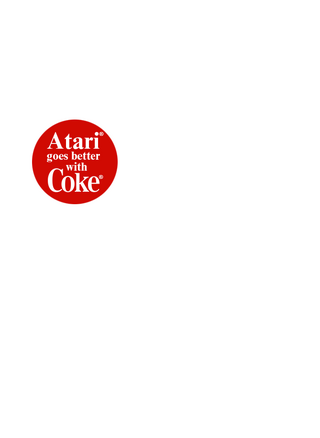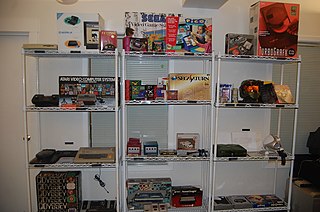
The Atari 2600 is a home video game console developed and produced by Atari, Inc. Released in September 1977 as the Atari Video Computer System, it popularized microprocessor-based hardware and games stored on swappable ROM cartridges, a format first used with the Fairchild Channel F in 1976. The VCS was bundled with two joystick controllers, a conjoined pair of paddle controllers, and a game cartridge—initially Combat and later Pac-Man. Sears sold the system as the Tele-Games Video Arcade. Atari rebranded the VCS as the Atari 2600 in November 1982, alongside the release of the Atari 5200.

The Atari 7800 ProSystem, or simply the Atari 7800, is a home video game console officially released by Atari Corporation in 1986 as the successor to both the Atari 2600 and Atari 5200. It can run almost all Atari 2600 cartridges, making it one of the first consoles with backward compatibility. It shipped with a different model of joystick from the 2600-standard CX40 and included Pole Position II as the pack-in game. Most of the announced titles at launch were ports of 1981–1983 arcade video games.

ColecoVision is a second-generation home video-game console developed by Coleco and launched in North America in August 1982. It was released a year later in Europe by CBS Electronics as the CBS ColecoVision.

E.T. the Extra-Terrestrial is a 1982 adventure video game developed and published by Atari, Inc. for the Atari 2600 and based on the film of the same name. The game's objective is to guide the eponymous character through various screens to collect three pieces of an interplanetary telephone that will allow him to contact his home planet.

Kaboom! is an action video game published in 1981 by Activision for the Atari 2600. The game involves a Mad Bomber dropping bombs at increasing speeds as the player controls a set of water buckets to catch them. The gameplay was based on the Atari arcade video game Avalanche (1978). Kaboom! was programmed by Larry Kaplan with David Crane coding the graphics for the buckets and Mad Bomber. It was the last game designed by Kaplan for Activision, who left the company shortly after it was released. The game was later ported by Paul Wilson for the Atari 5200 system.

Pitfall! is a video game developed by David Crane for the Atari 2600 and released in 1982 by Activision. The player controls Pitfall Harry, who has a time limit of 20 minutes to seek treasure in a jungle. The game world is populated by enemies and hazards that variously cause the player to lose lives or points.
1982 was the peak year for the golden age of arcade video games as well as the second generation of video game consoles. Many games were released that would spawn franchises, or at least sequels, including Dig Dug, Pole Position, Mr. Do!, Zaxxon, Q*bert, Time Pilot and Pitfall! The year's highest-grossing video game was Namco's arcade game Pac-Man, for the third year in a row, while the year's best-selling home system was the Atari 2600. Additional video game consoles added to a crowded market, notably the ColecoVision and Atari 5200. Troubles at Atari late in the year triggered the video game crash of 1983.

Ultima: Escape from Mt. Drash is a role-playing video game published for the VIC-20 home computer by Sierra On-Line in 1983.

Golf is a 1980 sports video game programmed by Michael Lorenzen for Atari, Inc. and the Atari 2600. It is based on the traditional sport of golf. The game allows one or two players to play nine holes of the game, featuring various obstacles.

Home Entertainment Suppliers Pty. Ltd. is an Australian company that distributes computer games and gaming equipment. HES' offices are based in Riverwood, Sydney. HES's founder and managing director is Sebastian Giompaolo.

The Atari Flashback is a line of dedicated video game consoles produced since 2004, currently designed, produced, published and marketed by AtGames under license from Atari SA. The Flashback consoles are "plug-and-play" versions of the 1970s Atari 2600 console with built-in games rather than using ROM cartridges. The latest home console model, Atari Flashback 12 Gold, was released in 2023 and has 130 games.
Star Wars: Return of the Jedi: Ewok Adventure, also known as Revenge of the Jedi: Game I, is a cancelled 1983 shoot 'em up video game based on the 1983 Star Wars film Return of the Jedi. The game was developed by Atari Games and was to be published by Parker Brothers on the Atari 2600. Although it was completed, the game was never released for sale, as the marketing department of Parker Brothers considered the controls too difficult to master. A prototype cartridge surfaced in 1997.
In the history of video games, the second-generation era refers to computer and video games, video game consoles, and handheld video game consoles available from 1976 to 1992. Notable platforms of the second generation include the Fairchild Channel F, Atari 2600, Intellivision, Odyssey 2, and ColecoVision. The generation began in November 1976 with the release of the Fairchild Channel F. This was followed by the Atari 2600 in 1977, Magnavox Odyssey² in 1978, Intellivision in 1980 and then the Emerson Arcadia 2001, ColecoVision, Atari 5200, and Vectrex, all in 1982. By the end of the era, there were over 15 different consoles. It coincided with, and was partly fuelled by, the golden age of arcade video games. This peak era of popularity and innovation for the medium resulted in many games for second generation home consoles being ports of arcade games. Space Invaders, the first "killer app" arcade game to be ported, was released in 1980 for the Atari 2600, though earlier Atari-published arcade games were ported to the 2600 previously. Coleco packaged Nintendo's Donkey Kong with the ColecoVision when it was released in August 1982.

Pepsi Invaders is a non-commercially released 1983 fixed shooter video game developed by Atari, Inc. for the Atari 2600. It was commissioned by The Coca-Cola Company to be handed out to salespeople at their 1983 sales convention. A reskin of the system's version of Space Invaders, the player shoots down a flying formation of letters spelling "PEPSI", Coca-Cola's long-time rival. Only 125 copies were distributed.

Video game collecting is the hobby of collecting and preserving video games, video game consoles, and related memorabilia. Most video game consoles, and their games, are considered to be collectors' items years after their discontinuation due to their functional longevity and cultural significance. Collectors usually narrow their search to games holding characteristics they enjoy, such as being published for a specific video game console, being of certain genre, or featuring a specific character.

Pac-Man is a 1982 maze video game developed and published by Atari, Inc. under official license by Namco, and an adaptation of the 1980 arcade game Pac-Man. The player controls the title character, who attempts to consume all of the wafers in a maze while avoiding four ghosts that pursue him. Eating flashing wafers at the corners of the screen causes the ghosts to temporarily turn blue and flee, allowing Pac-Man to eat them for bonus points. Once eaten, a ghost is reduced to a pair of eyes, which return to the center of the maze to be restored.

The Atari video game burial was a mass burial of unsold video game cartridges, consoles, and computers in a New Mexico landfill site undertaken by the American video game and home computer company Atari, Inc. in 1983. Before 2014, the goods buried were rumored to be unsold copies of E.T. the Extra-Terrestrial (1982), one of the largest commercial video game failures and often cited as one of the worst video games ever released, and the 1982 Atari 2600 port of Pac-Man, which was commercially successful but critically maligned.

Tooth Protectors is a video game for the Atari 2600 video game console. It is an early example of an advergame, released exclusively via mail order in 1983 by American company Johnson & Johnson.

Red Sea Crossing is a Christian side-scrolling video game for the Atari 2600. Released for mail order only in 1983, its existence went unrecorded until it was discovered at a garage sale in 2007. Only two verified copies have been found, making it one of the rarest published video games.

















